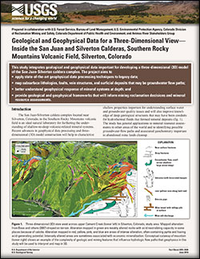Geological and geophysical data for a three-dimensional view—Inside the San Juan and Silverton Calderas, Southern Rocky Mountains Volcanic Field, Silverton, Colorado
Links
- Document: Report (8.83 MB pdf)
- Download citation as: RIS | Dublin Core
Introduction
The San Juan-Silverton caldera complex located near Silverton, Colorado, in the Southern Rocky Mountains volcanic field is an ideal natural laboratory for furthering the understanding of shallow-to-deep volcanic-related mineral systems. Recent advances in geophysical data processing and three-dimensional (3D) model construction will help to characterize shallow properties important for understanding surface water and groundwater quality issues and will also improve knowledge of deep geological structures that may have been conduits for hydrothermal fluids that formed mineral deposits. The study has general applications to mineral resource assessments in other areas of the world and to identifying possible groundwater flow paths and associated geochemistry important in abandoned mine lands cleanup.
Silverton, Colorado, is the site of a spectacular succession of igneous rocks that formed beginning about 35 million years ago (Ma). Base metals (copper, lead, and zinc) and precious metals (silver and gold) mined from the late 1870s to 1991 owe their existence to a 25-million-year cycle of igneous activity. The presence of economic, base, and precious metal deposits within a complex geological setting were largely responsible for stimulating studies by the U.S. Geological Survey (USGS) conducted during the early 20th century. The focus of investigations in the late 20th and 21st centuries have broadened in scope to include abandoned mine lands (AML) investigations. The legacy of hard rock mining in headwater catchment areas caused environmental challenges for local communities and downstream water resource users. The Gold King Mine, located a few kilometers north of Silverton, illustrates the potential environmental effects of abandoned mines. On August 5, 2015, during reclamation efforts at the Gold King Mine, a breach of collapsed workings sent approximately 3 million gallons of acidic and metal-rich mine water into the upper Animas River, a tributary to the Colorado River Basin. Mining-related sources of metals and acidity add to geological sources of metals in surface water and groundwater. Weathering processes of altered and mineralized rock have been a source of acid rock drainage that have been ongoing for millennia.
Suggested Citation
Yager, D.B., Anderson, E.D., Rodriguez, B.D., Deszcz-Pan, M., and Smith, B.D., 2019, Geological and geophysical data for a three-dimensional view—Inside the San Juan and Silverton calderas, Southern Rocky Mountains volcanic field, Silverton, Colorado: U.S. Geological Survey Fact Sheet 2019-3026, 4 p., https://doi.org/10.3133/fs20193026.
ISSN: 2327-6932 (online)
ISSN: 2327-6916 (print)
Study Area
Table of Contents
- Introduction
- What is a Caldera?
- Data For Developing a 3D Model
- Electromagnetic Data
- Magnetotelluric Data
- Summary
- References
| Publication type | Report |
|---|---|
| Publication Subtype | USGS Numbered Series |
| Title | Geological and geophysical data for a three-dimensional view—Inside the San Juan and Silverton Calderas, Southern Rocky Mountains Volcanic Field, Silverton, Colorado |
| Series title | Fact Sheet |
| Series number | 2019-3026 |
| DOI | 10.3133/fs20193026 |
| Publication Date | June 04, 2019 |
| Year Published | 2019 |
| Language | English |
| Publisher | U.S. Geological Survey |
| Publisher location | Reston VA |
| Contributing office(s) | Geology, Geophysics, and Geochemistry Science Center |
| Description | 4 p. |
| Country | United States |
| State | Colorado |
| County | San Juan County |
| Online Only (Y/N) | N |


